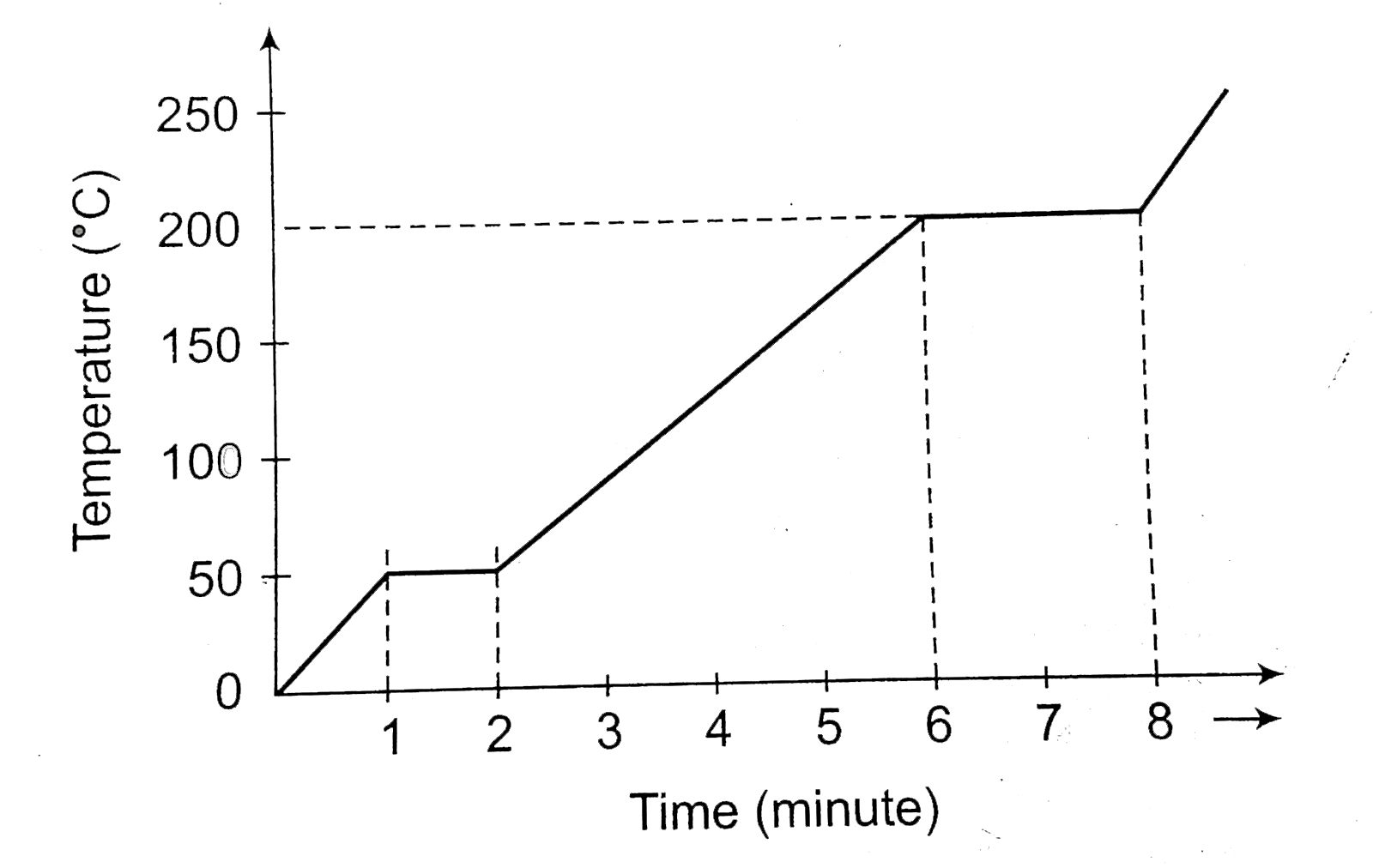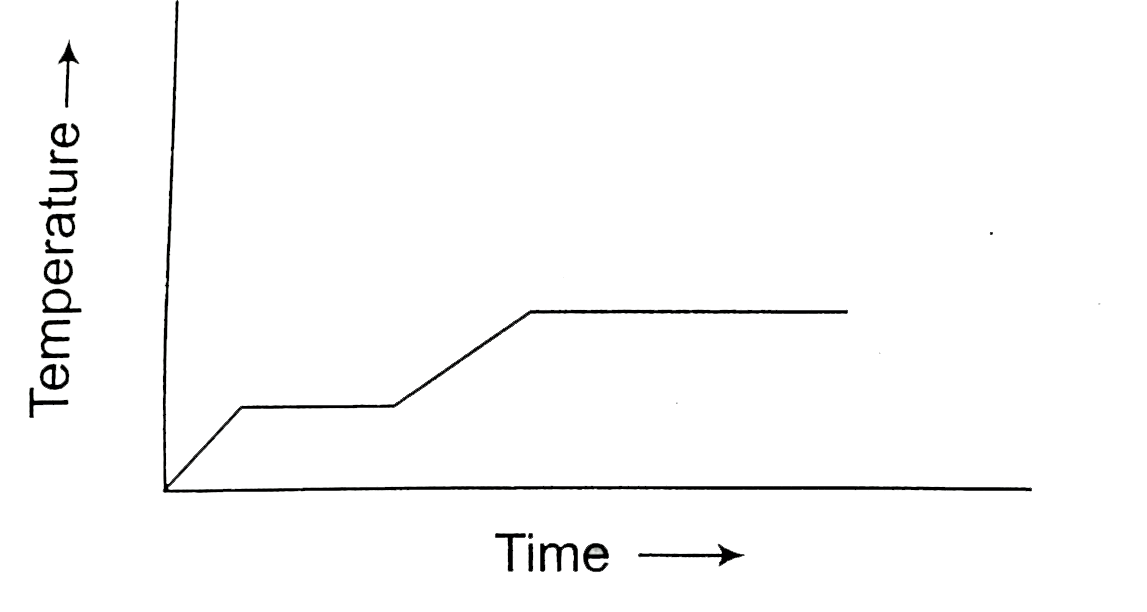Complete Solutions to Physics of chapter THERMAL EXPANSION AND CALORIMETRY of Class 12 book with complete answers and questions
| Class 12 | PHYSICS |
| Chapter | THERMAL EXPANSION AND CALORIMETRY |
| DISHA | Physics |
| Number Of Questions | 29 |
| Academic Year | 2023-24 |
A galss flask is filled up to a mark with 50 cc of mercury at `18^@C`. If the flask and contents are heated to `38^@C`, how mech mercury will be above the mark (`alpha` for glass is `9xx10^(-6)//^@C` and coeffiecient of real expansion of mercury is `180xx10^(-6)//^@C`)?
View SolutionThe coefficient of apparent expansion of mercury in a glass vessel is `153xx10^(-6)//^(@)C` and in a steel vessel is `114xx10^(-6)//^(@)C`. If `alpha` for steel is `12xx10^(-6)//^(@)C`, then that of glass is
View SolutionAn iron tyre is to be fitted onto a wooden wheel 1.0 m in diameter. The diameter of the tyre is 6 mm smaller than that of wheel the tyre should be heated so that its temperature increases by a minimum of (coefficient of volume expansion of iron is `3.6xx10^-5//^@C`)
View SolutionA rod of length `20 cm` is made of metal. It expands by `0.075 cm` when its temperature is raised from `0^(@)C` to `100^(@)C`. Another rod of different metal `B` having the same length expands by `0.045 cm` for the same change in temperature. A third rod of the same length is composed of two parts, one of metal `A` and the oher of metal `B`. This rod expandss by `0.060 cm` for the same change in temperature. The portion made of metal `A` has the length :
View SolutionA glass flask of volume one litre at `0^(@)C` is filled, level full of mercury at this temperature. The flask and mercury are now heated to `100^(@)C`. How much mercury will spill out if coefficient of volume expansion of mercury is `1.82 xx 10^(-4)//^(@)C` and linear expansion of glass is `0.1 xx 10^(-4)//^(@)C` respectively?
View SolutionThe apparent coefficient of expansion of liquid, when heated in a copper vessel is `C` and when heated in a silver vessel is `S`. If `A` is the linear coefficient of expansion of Copper, linear expansion coefficient of silver is
View SolutionThe apparent coefficient of expansion of liquid, when heated in a copper vessel is `C` and when heated in a silver vessel is `S`. If `A` is the linear coefficient of expansion of Copper, linear expansion coefficient of silver is
View SolutionA piece of metal weighs 46 g in air and 30 g in lipuid of density `1.24 xx 10^3 kg m^(-3)` kept at `27^0C`. When the temperature of the liquid is raised to `42^0C` the metal piece weights 30.5 g . The density of the liqued at `42^0 C` is `1.20 xx 10^3 kg m^(-3)`. Calculate the coefficient of linear expandsion of the metal.
View Solution2kg of ice at `20^@C` is mixed with 5kg of water at `20^@C` in an insulating vessel having a negligible heat capacity. Calculate the final mass of water remaining in the container. It is given that the specific heats of water & ice are `1kcal//kg//^@C` and `0.5`
`kcal//kg//^@C` while the latent heat of fusion of ice is `80kcal//kg`
View SolutionA lead bullet just melts when stopped by an obstacle. Assuming that 25 per cent of the heat is absorbed by the obstacle, find the velocity of the bullet if its initial temperature is `27^@C` . (Melting point of lead `= 327^@C`, specific heat of lead `=0.03 cal//g.^@C`, latent heat of fusion of lead `=6 cal//g, J = 4.2 J//cal`).
View SolutionThe temperature of equal masses of three different liquids A,B and C are `12^@C, 19^@C and 28^@C` respectively. The temperature when A and B are mixed is `16^@C` and when B and C are mixed it is `23^@C`. What should be the temperature when A and C are mixed?
View Solution`50 gm `of copper is heated to increase its temperature by `10^(@)C.` If the same quantity of heat is given to `10 gm `of water, the rise in its temperature is (Specific heat of copper`=420 Joule-kg^(-1)@C^(-1)`
View SolutionA beaker contains 200 g of water. The heat capacity of the beaker is equal to that of 20 g of water. The initial temperature of water in the beaker is `20^@C` .If 440 g of hot water at `92^@C` is poured in it, the final temperature (neglecting radiation loss) will be nearest to
View SolutionCalorie is defined as the amount of heat required to raise temperature of 1 g of water by `1^@C` and it is defined under which of the following conditions?
View Solution5A bullet moving with a uniform velocity v, stops suddenly after hitting the target and the whole mass melts be m, specific heat S, initial temperature `25^(@)C,` melting point `475^(@)C` and the latent heat L. Then v is given by
View SolutionA stationary object at `4^(@)C` and weighing `3.5 kg` falls from a height of `2000 m` on a snow mountain at `0^(@)C.` If the temperature of the object just before hitting the snow is `0^(@)C `and the object comes to rest immediately? (g=10m//s^(2))` and heat of ice `=3.5xx10^(5) joule //sec), then the object will melt
View SolutionThe density of a substance at `0^(@)C` is `10 g//c c` and at `100^(@)C`, its density is `9.7 g//c c`. The coefficient of linear expansion of the substance is
View SolutionThe real coefficient of volume expansion of glycerine is `0.000597per^(@)C` and linear coefficient of expansion of glass is `0.000009par^(@)C` . Then the apparent volume coefficient of glycerine is
View SolutionA constant volume gas thermometer shows pressure readings of `50 cm` and `90 cm` of mercury at `0^(@)C` and `100^(@)C` respectively, The temperature of the bath when pressure reading is `60 cm` of mercury.
View Solution
A student takes 50 g wax (specific heat `=0.6 kcal//kg^(@)C`) and heats it till it boils. The graph between temperature and time is as follows. Heat supplied to the wax per minute and boiling point are respectively.
View Solution
Heat is supplied to a certain homogeneous sample of matter, at a uniform rate. Its temperature is plotted against time, as shown Which of the following conclusions can be drawn?
(i) Its specific heat capacity is greater in the solid state than the liquid state.
(ii) Its specific heat capacity is greater in the liquid state than in the solid state.
(iii) Its latent heat of vaporization is greater than its latent heat of fusion.
(iv) Its latent heat of vaporization is smaller than its latent heat of fusion
View SolutionA bimetallic strip is formed out of two identical strips one of copper and the other of brass. The co-efficients of linear expansion of the two metals are `alpha_(C)` and `alpha_(B)`. On heating, the the strip bends to form an are of radius of curvature `R`. Then `R` is
View SolutionWhen a bimetallic strip is heated, it
View SolutionIn a thermally insulated tube of cross sectional area `4cm^(2)` a liquid of thermal expansion coefficeint `10^(3)K^(-1)` is flowing. Its velocity at the entrance is `0.1m//s`. At the middle of the tube a heater of a power of 10 kW is heating the liquid. The specific heat capacity of the liquid is 1.5 kJ/(kg,K), and its density is `1500kg//m^(3)` at the entrance.
Q. The rise in temperature of the liquid as it pass through the tube is
View SolutionIn a thermally insulated tube of cross sectional area `4cm^(2)` a liquid of thermal expansion coefficeint `10^(3)K^(-1)` is flowing. Its velocity at the entrance is `0.1m//s`. At the middle of the tube a heater of a power of 10 kW is heating the liquid. The specific heat capacity of the liquid is 1.5 kJ/(kg,K), and its density is `1500kg//m^(3)` at the entrance.
Q. What is the density of liquid at the exit?
View SolutionIn a thermally insulated tube of cross sectional area `4cm^(2)` a liquid of thermal expansion coefficeint `10^(3)K^(-1)` is flowing. Its velocity at the entrance is `0.1m//s`. At the middle of the tube a heater of a power of 10 kW is heating the liquid. The specific heat capacity of the liquid is 1.5 kJ/(kg,K), and its density is `1500kg//m^(3)` at the entrance.
Q. How much bigger is the volume rate of flow at the end of the tube than at the entrance in cubic meters?
View SolutionStatement-1: Fahrenheit is the smallest unit measuring temperature
Statement-2: Fahrenheit was the first temperature scale used for measuring temperature
View SolutionStatement-1: A brass disc is just fitted in a hole in a steel plate. The system mst be cooled to loosen the disc from the hole
Statement-2: The coefficient of linear expansion for brass is greater than the coefficient of linear expansion for steel.
View SolutionStatement-1: Latent heat of fusion of ice is `336000Jkg^(-1)`
Statement-2: Latent heat refers to change of state without any change in temperature.
View Solution
Physics questions and complete solutions for chapter THERMAL EXPANSION AND CALORIMETRY of DISHA PHYSICS (HINGLISH) of Class 12